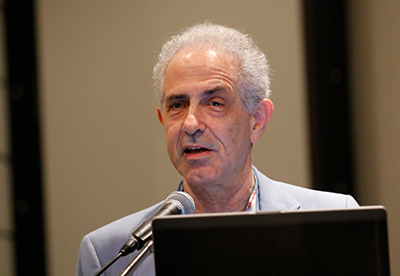Researchers Unveil New Algorithm for Treating Patients With Adult ADHD

Many people think that attention-deficit/hyperactivity disorder (ADHD) is a pediatric disorder, but symptoms often persist into adulthood. Estimates suggest that about 4 percent of adults have ADHD.
Fortunately, good treatment options including medications are available, though psychiatrists who specialize in treating adults may not be fully aware of the recommended treatment strategies. To help, investigators at Harvard South Shore Medical Center today unveiled a new Adult ADHD Treatment Algorithm at APA’s Annual Meeting.
As is the case when treating patients with pediatric ADHD, stimulants such as methylphenidate or amphetamines are considered front-line treatments for adults with ADHD. These medications are well tolerated and effective and can easily be used alongside other psychotropic medications, said David Osser, M.D. (pictured above), one of the algorithm authors, who chaired the session. Osser is an associate professor of psychiatry at Harvard Medical School.
Before prescribing medications for adults with ADHD, the clinician must first make sure the patient does not have any untreated glaucoma, narrow angle glaucoma (whether treated or not), and pheocytochroma (a tumor of the adrenal glands). Patients with these conditions should not be prescribed stimulants or the antidepressant atomoxetine (considered a second-line ADHD agent). Treated open angle glaucoma, hyperthyroidism, and cardiovascular problems like hypertension or angina are considered relative contraindications. Psychiatrists are advised to hold off on initiating stimulants or atomoxetine until receiving medical clearance.
Psychosis is also a relative contraindication, said session co-presenter Bushra Awidi, M.D., a clinical fellow in psychiatry at Harvard South Shore. Comorbid psychosis needs to be treated and in control prior to initiating ADHD medications.
After ruling out any medical contraindications, the clinician can choose between methylphenidate or amphetamine with discretion; there are no data to suggest there is much difference between these agents. Clinicians treating pregnant women with ADHD should make medication decisions based upon the severity and impairment of the patient’s symptoms, Awidi said.
Whatever stimulant is chosen should be initially prescribed in an immediate-release formulation, Awidi advised, as effectiveness and side effects can be identified quickly and dosage adjusted as needed. She recommended titrating the medication for at least four weeks to find an optimal profile of symptom improvements versus side effects, and then switching to an extended-release formula of that stimulant.
Adults can often require doses as high as 1-1.3 mg/kg per day for methylphenidate or 0.6-0.9 mg/kg day for amphetamine before symptom improvements are seen. If after four weeks no improvements are seen, clinicians are advised to switch patients to the other class of stimulant and titrate again for four weeks, she continued.
If neither stimulant class results in symptom improvement, the algorithm suggests treating the patient with atomoxetine, starting with about 40 mg/day. A clinically meaningful response to atomoxetine can take four to six weeks, and the maximal response may take several more weeks after that. At the moment, the algorithm does not make any recommendations on the use of any other medications used for ADHD, such as clonidine, guanfacine, modafinil, or bupropion.
This standard algorithm holds true for ADHD patients with most psychiatric comorbidities, though Osser highlighted two psychiatric conditions clinicians should pay close attention to when considering treatment initiation for ADHD: bipolar disorder and substance use disorder.
The use of stimulants in patients with uncontrolled bipolar poses significant risks of emergent mania, so while stimulants can be used to treat patients with ADHD and bipolar disorder, they should only be initiated after the patient’s mood is stabilized and at a lower dose than prescribed to patients without this condition.
The presence of certain substance use disorders may also require adjustments to the ADHD treatment algorithm. In general, the standard protocol applies, but to avoid risks of abuse and diversion, clinicians should first treat these patients with an extended-release formulation even though it takes longer to observe effects. Clinicians should also try to treat patients simultaneously for both ADHD and substance use, unless the substance use disorder is severe. In that case, Osser recommended that the patient be treated for the substance use disorder first to achieve sobriety.
Patients with cocaine use disorder have shown improvement in ADHD symptoms and a reduction in cocaine use in response to amphetamines, so this stimulant class specifically is the top recommended choice. For people with methamphetamine use disorder, amphetamines should be avoided, but methylphenidate has been shown to be effective at reducing symptoms of ADHD and also can reduce drug use as well. For patients with ADHD and co-occurring alcohol use disorder, atomoxetine can be given first, Osser said, as there is a study that suggests atomoxetine can reduce heavy drinking days gradually over time.
Osser said he hoped that clinicians will find the new algorithm beneficial, but acknowledged that more research needs to be done on adult ADHD and its treatment. “Much of our decision-making process was based on what works when treating children, and we need more direct evidence for adults,” he concluded.
(Image: David Hathcox)
|
|
|
|
Advertisement
 |
|
 |
|
|



